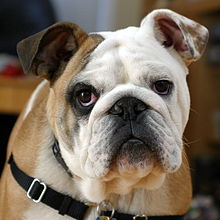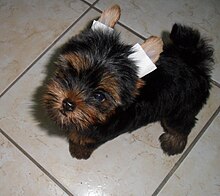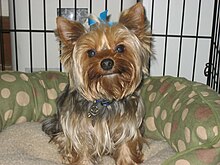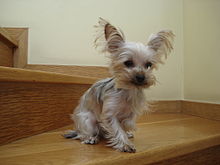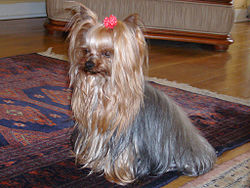Appearance
The Bulldog is a breed with characteristically wide head and shoulders along with a pronounced mandibular prognathism. There are generally thick folds of skin on a Bulldog's brow; round, black, wide-set eyes; a short muzzle with characteristic folds called "rope" above the nose; hanging skin under the neck; drooping lips and pointed teeth. The coat is short, flat and sleek, with colors of red, fawn, white, brindle (mixed colors, often in waves or irregular stripes), and piebald.
In the US, a typical mature male weighs approximately 55-60 pounds. Mature females weigh in at approximately 45 pounds. In the United Kingdom, the breed standards are 55 pounds for a male and 50 pounds for a female.
Bulldogs are one of the few breeds whose tail is naturally short and curled and thus is not cut or docked as with some other breeds.
According to the American Kennel Club (AKC) a Bulldog's "disposition should be equable and kind, resolute and courageous (not vicious or aggressive), and demeanor should be pacific and dignified. These attributes should be countenanced by the expression and behavior."
Breeders have worked to reduce/remove aggression from these dogs, and as such, the Bulldog is known to be of good temperament. Some, particularly males, may not get along with other dogs or strangers but most have a friendly, patient nature. Generally, Bulldogs are known for getting along well with children, other dogs, and pets. They can be so attached to home and family that they will not venture out of the yard without a human companion and are more likely to sleep on someone's lap than chase a ball around the yard.
Adult female Bulldog with under-bite
Bulldog breed clubs put the average life span of the breed at 8–12 years, although a UK survey puts it at 6.5 years. The leading cause of death of Bulldogs in the survey was cardiac related (20%), cancer (18%) and old age (9%). Those that died of old age had an average lifespan of 10 to 11 years.
Statistics from the Orthopedic Foundation for Animals indicate that of the 467 Bulldogs tested between 1979 and 2009 (36 years), 73.9% were affected by hip dysplasia, the highest amongst all breeds. Similarly, the breed has the worst score in the British Veterinary Association/Kennel Club Hip Dysplasia scoring scheme, although only 22 Bulldogs were tested in the scheme. Patellar luxation is another condition which affects 6.2% of Bulldogs.
Some individuals of this breed are prone to interdigital cysts, which are cysts that form between the toes. These cause the dog some discomfort, but are treatable either by vet or an experienced owner. They may also suffer from respiratory problems. Other problems can include cherry eye, a protrusion of the inner eyelid (which can be corrected by a veterinarian), allergies, and hip issues in older Bulldogs.
Over 80% of Bulldog litters are delivered by Caesarean section because their characteristically large heads can become lodged in the mother's birth canal. The folds or "rope" on a Bulldog's face should be cleaned daily to avoid unwanted infections caused by moisture accumulation. Some Bulldogs' naturally curling tails can be so tight to the body as to require regular cleaning and ointment.
Like all dogs, Bulldogs require daily exercise. If not properly exercised it is possible for a Bulldog to become overweight, which could lead to heart and lung problems, as well as joint issues. Bulldogs are said to be "the most relentless farters in the canine world."
Bulldogs are very sensitive to heat. Extra caution should be practiced in warmer climates and during summer months. Bulldogs must be given plenty of shade and water, and must be kept out of standing heat. Air conditioning and good ventilation is required to keep them healthy and safe. Bulldogs actually do most of their sweating through the pads on their feet and accordingly enjoy cool floors. Like all brachycephalic or "short-faced" breeds, Bulldogs can easily become overheated and even die from hyperthermia. They can be big snorters and heavy breathers, and they tend to be loud snorers. Bulldog owners can keep these issues under control by staying aware and protecting their Bulldog(s) from these unsafe conditions.
In January 2009, after the BBC documentary Pedigree Dogs Exposed, The Kennel Club introduced revised breed standards for the British Bulldog, along with 209 other breeds, to address health concerns. Opposed by the British Bulldog Breed Council, it was speculated by the press that the changes would lead to a smaller head, fewer skin folds, a longer muzzle, and a taller thinner posture, in order to combat perceived problems with respiration and breeding due to head size and width of shoulders.
Despite slow maturation so that growing up is rarely achieved by two and a half years, bulldogs lives are relatively short and at five to six years of age they are starting to show signs of aging.
In time, the original old English Bulldog was crossed with the pug. The outcome was a shorter, wider dog with a brachycephalic skull. Though today's Bulldog looks tough, he cannot perform the job he was originally created for as he cannot withstand the rigors of running and being thrown by a bull, and also cannot grip with such a short muzzle.
The oldest single breed specialty club is The Bulldog Club (England), which was formed in 1878. Members of this club met frequently at the Blue Post pub on Oxford Street in London. There they wrote the first standard of perfection for the breed. In 1891 the two top Bulldogs, Orry and Dockleaf, competed in a contest to see which dog could walk the farthest. Orry was reminiscent of the original Bulldogs, lighter boned and very athletic. Dockleaf was smaller and heavier set, more like modern Bulldogs. Dockleaf was declared the winner that year. Although some argued that the older version of the Bulldog was more fit to perform, the modern version’s looks won over the fans of the breed because they proved they were equally as fit and athletic in the walking competition.
At the turn of the 20th century, Ch. Rodney Stone became the first Bulldog to command a price of $5000 when he was bought by controversial Irish-American political figure Richard Croker
In the US, a typical mature male weighs approximately 55-60 pounds. Mature females weigh in at approximately 45 pounds. In the United Kingdom, the breed standards are 55 pounds for a male and 50 pounds for a female.
Bulldogs are one of the few breeds whose tail is naturally short and curled and thus is not cut or docked as with some other breeds.
Temperament
Despite their famous "sourpuss" expression, Bulldogs are generally docile and tractable. However, they can move very quickly over short distances. Bulldogs do not need a lot of physical exercise, so they are well-suited for living in apartments and other urban environments. They are friendly and gregarious, but occasionally willful. The phrase "stubborn as a Bulldog" may derive from observing an agitated Bulldog. They rank 78th out of 80 in Stanley Coren's The Intelligence of Dogs, holding the lowest degree of working/obedience intelligence.According to the American Kennel Club (AKC) a Bulldog's "disposition should be equable and kind, resolute and courageous (not vicious or aggressive), and demeanor should be pacific and dignified. These attributes should be countenanced by the expression and behavior."
Breeders have worked to reduce/remove aggression from these dogs, and as such, the Bulldog is known to be of good temperament. Some, particularly males, may not get along with other dogs or strangers but most have a friendly, patient nature. Generally, Bulldogs are known for getting along well with children, other dogs, and pets. They can be so attached to home and family that they will not venture out of the yard without a human companion and are more likely to sleep on someone's lap than chase a ball around the yard.
Health
Statistics from the Orthopedic Foundation for Animals indicate that of the 467 Bulldogs tested between 1979 and 2009 (36 years), 73.9% were affected by hip dysplasia, the highest amongst all breeds. Similarly, the breed has the worst score in the British Veterinary Association/Kennel Club Hip Dysplasia scoring scheme, although only 22 Bulldogs were tested in the scheme. Patellar luxation is another condition which affects 6.2% of Bulldogs.
Some individuals of this breed are prone to interdigital cysts, which are cysts that form between the toes. These cause the dog some discomfort, but are treatable either by vet or an experienced owner. They may also suffer from respiratory problems. Other problems can include cherry eye, a protrusion of the inner eyelid (which can be corrected by a veterinarian), allergies, and hip issues in older Bulldogs.
Over 80% of Bulldog litters are delivered by Caesarean section because their characteristically large heads can become lodged in the mother's birth canal. The folds or "rope" on a Bulldog's face should be cleaned daily to avoid unwanted infections caused by moisture accumulation. Some Bulldogs' naturally curling tails can be so tight to the body as to require regular cleaning and ointment.
Like all dogs, Bulldogs require daily exercise. If not properly exercised it is possible for a Bulldog to become overweight, which could lead to heart and lung problems, as well as joint issues. Bulldogs are said to be "the most relentless farters in the canine world."
Bulldogs are very sensitive to heat. Extra caution should be practiced in warmer climates and during summer months. Bulldogs must be given plenty of shade and water, and must be kept out of standing heat. Air conditioning and good ventilation is required to keep them healthy and safe. Bulldogs actually do most of their sweating through the pads on their feet and accordingly enjoy cool floors. Like all brachycephalic or "short-faced" breeds, Bulldogs can easily become overheated and even die from hyperthermia. They can be big snorters and heavy breathers, and they tend to be loud snorers. Bulldog owners can keep these issues under control by staying aware and protecting their Bulldog(s) from these unsafe conditions.
In January 2009, after the BBC documentary Pedigree Dogs Exposed, The Kennel Club introduced revised breed standards for the British Bulldog, along with 209 other breeds, to address health concerns. Opposed by the British Bulldog Breed Council, it was speculated by the press that the changes would lead to a smaller head, fewer skin folds, a longer muzzle, and a taller thinner posture, in order to combat perceived problems with respiration and breeding due to head size and width of shoulders.
History
The term "Bulldog" was first mentioned in literature around 1500, the oldest spelling of the word being Bondogge and Bolddogge. The first reference to the word with the modern spelling is dated 1631 or 1632 in a letter by a man named Preswick Eaton where he writes: "procuer mee two good Bulldogs, and let them be sent by ye first shipp". The name "bull" was applied because of the dog's use in the sport of bull baiting. This entailed the setting of dogs (after placing wagers on each dog) onto a tethered bull. The dog that grabbed the bull by the nose and pinned it to the ground would be the victor. It was common for a bull to maim or kill several dogs at such an event, either by goring, tossing or trampling. Over the centuries dogs used for bull-baiting developed the stocky bodies and massive heads and jaws which typify the breed as well as a ferocious and savage temperament. Bull-baiting - along with bear-baiting - reached the peak of their popularity in England in the early 1800s until they were both made illegal by the Cruelty to Animals Act 1835. This amended the existing legislation to protect animals from mistreatment and included (as 'cattle') bulls, dogs, bears and sheep, so that bull and bear-baiting as well as cockfighting became prohibited. Therefore, the Old English Bulldog had outlived its usefulness in England as a sporting animal and its active or 'working' days were numbered. However, emigrants did have a use for such dogs in the New World. In mid-17th century New York, Bulldogs were used as a part of a city-wide round-up effort led by governor Richard Nicolls. Because cornering and leading wild bulls was dangerous, Bulldogs were trained to seize a bull by its nose long enough for a rope to be secured around its neck. Bulldogs as pets were continually promoted by dog dealer Bill George.Despite slow maturation so that growing up is rarely achieved by two and a half years, bulldogs lives are relatively short and at five to six years of age they are starting to show signs of aging.
In time, the original old English Bulldog was crossed with the pug. The outcome was a shorter, wider dog with a brachycephalic skull. Though today's Bulldog looks tough, he cannot perform the job he was originally created for as he cannot withstand the rigors of running and being thrown by a bull, and also cannot grip with such a short muzzle.
The oldest single breed specialty club is The Bulldog Club (England), which was formed in 1878. Members of this club met frequently at the Blue Post pub on Oxford Street in London. There they wrote the first standard of perfection for the breed. In 1891 the two top Bulldogs, Orry and Dockleaf, competed in a contest to see which dog could walk the farthest. Orry was reminiscent of the original Bulldogs, lighter boned and very athletic. Dockleaf was smaller and heavier set, more like modern Bulldogs. Dockleaf was declared the winner that year. Although some argued that the older version of the Bulldog was more fit to perform, the modern version’s looks won over the fans of the breed because they proved they were equally as fit and athletic in the walking competition.
At the turn of the 20th century, Ch. Rodney Stone became the first Bulldog to command a price of $5000 when he was bought by controversial Irish-American political figure Richard Croker


